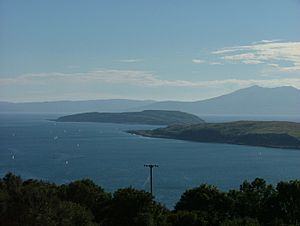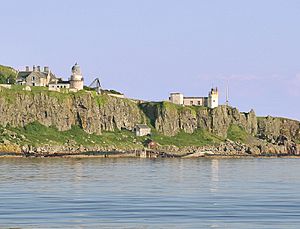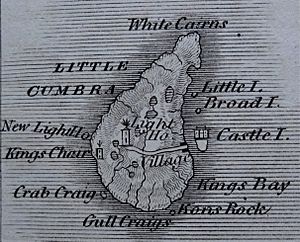Little Cumbrae facts for kids
| Gaelic name | Cumaradh Beag |
|---|---|
| Meaning of name | Little island of the Cymric people |
| OS grid reference | NS148517 |
| Coordinates | 55°43′N 4°57′W / 55.72°N 4.95°W |
| Physical geography | |
| Island group | Islands of the Clyde |
| Area | 313 hectares (1.21 sq mi) |
| Area rank | 84 |
| Highest elevation | Lighthouse Hill 123 metres (404 ft) |
| Administration | |
| Sovereign state | United Kingdom |
| Country | Scotland |
| Council area | North Ayrshire |
| Demographics | |
| Population | 0 |
Little Cumbrae (called Scots: Wee Cumbrae in Scots, and Scottish Gaelic: Cumaradh Beag in Gaelic) is an island in the Firth of Clyde. It is part of North Ayrshire, Scotland. People often call it Wee Cumbrae.
This small island is very different from its larger neighbour, Great Cumbrae. Little Cumbrae is rough and rocky, with many cliffs. It looks more like an island from the Hebrides than other islands in the Clyde.
Contents
What's in a Name?
The name Cumaradh comes from an old Gaelic word. It means "place of the Cymric people." These were people who spoke a language called Brittonic. They lived in the ancient Kingdom of Strathclyde.
Another idea is that Cumbrae comes from Kil Maura. This means "cell or church of a female saint." Over time, the island's name has changed. It was called Kumbrey around 1300 and Litill Comeray in 1515.
The Norse people, who were Vikings, also had a name for the Cumbraes. They called them Kumreyiar in their old stories.
Island Geography
Little Cumbrae is very close to its bigger neighbour, Great Cumbrae. Only about one kilometre separates them. The island is also just a few kilometres from the town of Largs on the mainland. Together, these two islands are known as The Cumbraes.
Unlike the green and fertile Great Cumbrae, Little Cumbrae is rugged. It has many cliffs and rocky areas. This makes it look more like islands found further north in Scotland.
Several small, uninhabited islands are found along Little Cumbrae's east coast. These include Castle Isle, the Broad Islands, and Trail Isle. Today, the main buildings on the island are at Little Cumbrae House. This is on the eastern shore, facing the Scottish mainland.
Island Rocks and Landforms
Little Cumbrae is mostly made of igneous rocks. These rocks formed from cooled lava. They are a mix of basalt and other lava flows. These rocks are cut by long, thin rock formations called dykes.
There are also some areas of sedimentary rock on the east side. These are sandstones. The island also shows signs of a raised beach. This is an old coastline that is now higher than the sea.
During the last ice age, a large glacier moved over the island. You can still see scratches on the rocks from this glacier. These scratches show it moved from north to south.
A Look at History

 |
|
| Little Cumbrae Lighthouse | |
| Location | Firth of Clyde |
|---|---|
| Coordinates | 55°43.2179′N 4°58.0236′W / 55.7202983°N 4.9670600°W |
| Year first constructed | 1793 |
| Year first lit | 1997 (current tower) |
| Automated | 1977 |
| Construction | Traditional white tower (inoperative) hexagonal/cylindrical tower |
| Focal height | 92 feet (28 m) |
| Range | nautical miles |
| Characteristic | Fl. W 6 sec |
Early Irish monks chose remote places like the Cumbraes to live. Little Cumbrae has at least six known caves. One story says a secret underwater passage connected Monks' Cave (now called Kings Cave) to the Isle of Bute.
Walter Stewart may have built a castle or hunting lodge here. His son, King Robert II, used to hunt deer on the island. The exact spot of this "Auld Castle" is not known today. It was used by Robert II in 1375 and 1384. Later, Oliver Cromwell's soldiers destroyed it in 1653.
Little Cumbrae Castle is a small, square tower built in the 1500s. It stands on Castle Island, just off Little Cumbrae. This castle was also used for a time.
In the early 1900s, Evelyn Stuart Parker owned the island. He turned the old farmhouse into a new "mansion house." Famous garden designer Gertrude Jekyll planned the gardens. Repairs were also made to the castle and the original lighthouse.
Little Cumbrae is also the birthplace of James Archbald. He was the first mayor of Carbondale, Pennsylvania.
Cumbrae Lighthouses
The first lighthouse on Little Cumbrae was built in 1757 by James Ewing. It was Scotland's second lighthouse. An open coal fire burned at the top of a round stone tower. You can still see parts of this old structure today.
The main Cumbrae Lighthouse was designed in 1793 by Thomas Smith. It was built for the Northern Lighthouse Board. This lighthouse is on the western shore of the island. It has a foghorn, a slipway, a jetty, and a boathouse.
The original oil lamps were replaced in 1826. In 1865, the first foghorn in Britain was installed here. The tower was fixed up in 1956. A solar-powered light was put in place in 1974. The 1793 tower has not been used since 1997. The light now shines from a newer, hexagonal tower next to the old generator house.
Island Ownership
Little Cumbrae was bought by a private owner in 2003. There were ideas to turn it into a memorial park, a nature reserve, or a place for company getaways.
The island was sold again in July 2009 for £2 million. A Scottish couple of Indian origin, Sarwan and Sunita Poddar, bought it. They opened a yoga and meditation centre there. They worked with a yoga teacher named Swami Ramdev. There were also rumours that the new owners planned to rename it "Peace Island," but they said this was not true.
See also
 In Spanish: Little Cumbrae para niños
In Spanish: Little Cumbrae para niños


